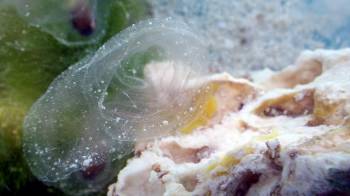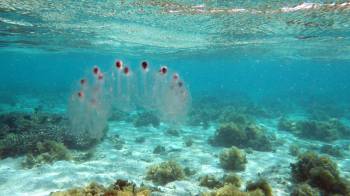Summary
Physical Description
Ecology
Life History & Behaviour
Feeding
Reproduction
Anatomy & Physiology
Sensory Systems (Focus Project)
Evolution & Systematics
Biogeographic Distribution
Conservation & Threats
References & Links | Reproduction
Salps undergo alternation of generations to maximise the speed of reproduction. Reproducing fast is important to salps as they need to act fast to take advantage of unpredictable phytoplankton blooms that come and go very quickly (Alldredge and Madin 1982).

|
|
|
Generation 1: Oozooid adult Pegea confoederata
(photo by Helen Twaddle, Heron Island)
|

|
|
|
Generation 2: Chain of blastozooid adults Pegea confoederata
(photo by Helen Twaddle, Heron Island)
|
Generation 1: The oozooid
This is the solitary generation of the salp life-cycle. The oozooid lives and feeds by itself and therefore reproduces asexually. Long stolons are produced and chains of blastozooid buds are deployed into the water column.
Generation 2: The Blastozooid
The chains of clones produced from the oozooid are the second, sexually reproducing generation. All blastozooids are females when young and as they become larger they undergo sexual reversal and become males. Larger males mate with smaller females and produce small oozoid embryos, which are born as live young (viviparous). During the foetus’ development, the mother is responsible for the nutrition of both of them and deal with this using a placental attachment. Once the oozooid is large enough (basically occupying the entire body of the parent), the oozooid is born and becomes it’s own being, completing the life cycle (Ruppert et al. 2004). |
|